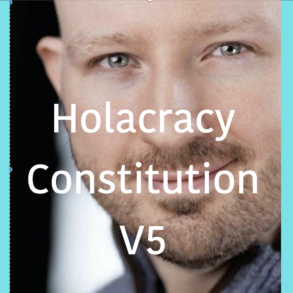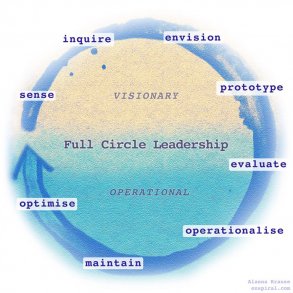By Andrew Chakhoyan and originally published on LinkedIn
“The key to management is to get rid of the managers,” Ricardo Semler once said. It’s important to point out that Mr. Semler, whose TED Talk went viral, isn’t an academic or an expert in management theory, he is the CEO of a successful manufacturing company. Surely, those views don’t represent mainstream thinking on organizational design today. But perhaps it is time to question whether the idea of ‘management,’ as it has been inherited from the industrial era, has outlived itself.
The World Bank estimates the global workforce at about 3.5 billion. By no means would I expect, much less advocate, that those who are employed today will transition into a management-light structure in the near or even medium term. At present, the vast majority of work involving human labor is still best carried out through traditional hierarchies with defined policies and procedures.
The post-management era is just beginning to dawn. It is the ever-accelerating pace of technological progress that is responsible for destroying the old paradigms.
In the world of VUCA (volatility, uncertainty, complexity, and ambiguity), it is the tech unicorns that will be the early adopters of the post-hierarchical model. In fact, some have already embraced it. Today’s competitive landscape is defined by one word: disruption. The ideas of incremental progress, continuous improvement, and process optimizations just don’t cut the mustard anymore. Those practices are necessary but insufficient. Enduring success, nowadays, is impossible without intrapreneurship, category-defining innovation, and unremitting business transformation.
The organizational dilemmas faced by ambitious disruptors are best exemplified by the experience of Netflix. Their HR guru, Patty McCord, identified a problem that appears obvious in retrospect: as businesses grow, so does complexity. But that comes at a cost of shrinking talent density.
The slide deck she developed with the CEO of Netflix, Reed Hastings, went viral, and Sheryl Sandberg referred to it as possibly the most important document to come out of Silicon Valley. That said, Patty McCord did not earn her accolades by identifying the problems. What captivated everyone’s imagination were the unorthodox solutions that she offered: “Over the years we learned that if we asked people to rely on logic and common sense instead of on formal policies, most of the time we would get better results, and at lower cost.”
The commentary on Netflix’s corporate culture often focuses on the concrete HR policies, such as self-allotted vacation, no travel expense reports, etc. But those examples are just derivatives of a larger vision — high business complexity need not be managed with standard processes and an ever-growing rulebook. Patty McCord advocated for the exact opposite: limit the tyranny of procedures, bring on board high-performers and let them self-manage in an environment of maximum flexibility.
The process of dealing with or controlling things or people is how we define management today. If this is not a red flag to a CEO running something other than a widget factory, then I don’t know what is. Controlling things no longer appears plausible, and controlling people is downright counterproductive. Steve Jobs hit the nail on the head when he said: “It doesn’t make sense to hire smart people and then tell them what to do; we hire smart people so they can tell us what to do.”
Apple’s co-founder is rightfully considered one of the greatest visionaries of our time, but had he been born in, say, the17th century or even 50 years earlier than he was, and uttered the same pronouncement, I doubt that it would have resonated with his contemporaries. The post-management era is just beginning to dawn. It is the ever-accelerating pace of technological progress, that is responsible for destroying the old paradigms.
Having smart people tell the landowners what to do in a pre-industrial society would not have led to better economic outcomes. In the best-case scenario, it would have invited ridicule. There was no evidence to suggest, at the time, that productivity and population growth were not one and the same.
While division of labor was the hallmark of the industrial era, it is becoming increasingly difficult today to parse out and allocate white-collar work in the form of specific/precise tasks. Regardless of how we describe the present, be it the digital epoch, the fourth industrial revolution era, or the second machine age, what it boils down to is that all work that requires supervision is being outsourced to robots and algorithms. Non-standard, creative, experimental work, on the other hand, doesn’t naturally lend itself to management.
Context Curator is the term I’d like to introduce into the business dictionary. To lead a project is not to assign tasks and monitor performance, but to empower, to define the broader context, and to organically link the work of one team with the rest of the business.
The second fundamental shift we are presently witnessing is that the mantra of first planning and then executing is no longer a viable strategy. What used to be known as muddling through is now called adopting and adapting to the fast-changing environment. Strategy, as we know it, is dead. Dealing with uncertainty is the number one challenge and, as the cliché goes, it’s the number one opportunity too. If your company isn’t the disruptor, it’s a clear sign that disruption is coming to it.
The bottom line is that outdated hierarchical models are no longer suited for the challenges of the modern economy. Every pillar of a traditional organization is now in flux; brilliantly conceptualized by Tanmay Vora.
The status quo is often protected by the vocabulary: directors direct, presidents preside, and managers manage. But all those activities are much less value-adding than they used to be. They constrain innovation and stifle creativity in the pursuit of order.
Contextual awareness, peripheral vision, design thinking, multidisciplinary approach, those are the terms trending in modern office-speak, and deservedly so. A project-based and titles-free organization — where yesterday’s team member is today’s team lead — can deliver the flexibility and agility that businesses are yearning for.
Context Curator is the term I’d like to introduce into the business dictionary. To lead a project is not to assign tasks and monitor performance, but to empower, to define the broader context, and to organically link the work of one team with the rest of the business. To be sure, I am not suggesting that all teams must emerge organically and work harmoniously with no one in charge. Quite the opposite, I think the key attribute of a future-proofed manager should be their willingness to be accountable to the team and to foster a culture of responsibility within it.
Following the example of Netflix and striving for higher talent density is only half the battle. Curating the context for, as opposed to managing, high-performers is the key to unleashing their full potential.
Recognizing the inevitability of transition towards the new organizational structures, I find myself a bit anxious. Having built a career in a world of robust hierarchies, I struggle to imagine what it’ll be like to join a perfectly flat organization. However, one person’s chaos is another’s creative process. As it goes with all conventions, it’s hard to let go, but when they are gone, one struggles to remember why we had them in the first place.
Republished by permission of the author.









Thanks for sharing these thoughts. What comes through most saliently and poignantly to me here is the ambivalence and uncertainty the author seems to be experiencing personally while moving through this transition in thinking.
Several of the workplaces cited by Laloux, such as Morning Star Tomato and FAVI, are factory-based manufacturing facilities, not white-collar, with plenty of procedural work–and in these places, equally as in more “creative” settings, it turns out that giving the workers control over the work leads to better outcomes. The work done by the home health nurses of Buurtzorg is not much different now than it was before the digital age: check in on people, change bandages, give medication, and so on–it turns out this service, too, goes much better when management gets out of the way. The exemplar offered here, Netflix, has over 4,000 employees–surely not all of them have “creative” positions, yet Netflix’s enlightened policies apply to all. It’s gone so far that even the military, to a limited extent, concedes the value of abolishing traditional hierarchies and applying a “Team of Teams” (in McChrystal’s phrase) approach instead.
We are in a time of change, shifts that many have been yearning for for generations, and it comes not a moment too soon, as the systems of hierarchical control and misplaced values are busily destroying the basis for human life on this planet. I’ve been living the change long enough to disagree with the author on several points: I hope to see as many people transition into a differently managed structure as soon as possible, regardles of type of labor. I also believe smart (or randomly selected–did you know that’s how offices were filled in ancient Athens?) people telling landowners what to do in pre-industrial society would indeed have led to better economic outcomes (though economic outcomes are a weak reward compared with quality of life, which would also likely have been better). Though most pre-industrial existence took place in settings where private land ownership did not exist; instead communities self-managed the commons in a more egalitarian manner (see Ostrom’s work, for example). That way of life survived far longer than our hierarchical one has so far. For a further view of pre-historical self-management, check out Jessica Prentice’s article, “The Most Dangerous Notion in Reinventing Organizations.”
All that said, while to me “context curator” sounds overly jargony (tailor-made for the next edition of “Bullshit Bingo”!), i agree with the basic direction and argument: Get the organizational design right, and many good things will follow.